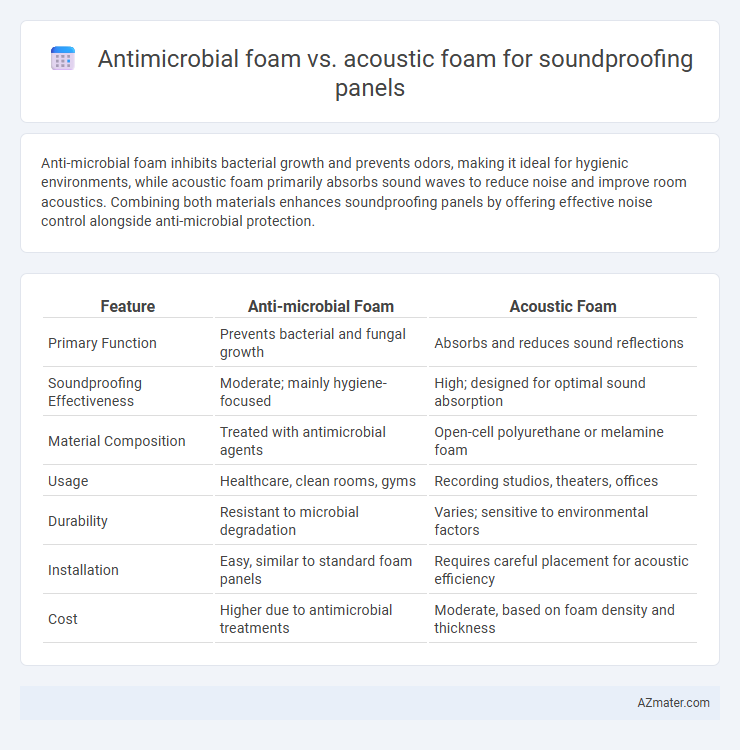Anti-microbial foam inhibits bacterial growth and prevents odors, making it ideal for hygienic environments, while acoustic foam primarily absorbs sound waves to reduce noise and improve room acoustics. Combining both materials enhances soundproofing panels by offering effective noise control alongside anti-microbial protection.
Table of Comparison
| Feature | Anti-microbial Foam | Acoustic Foam |
|---|---|---|
| Primary Function | Prevents bacterial and fungal growth | Absorbs and reduces sound reflections |
| Soundproofing Effectiveness | Moderate; mainly hygiene-focused | High; designed for optimal sound absorption |
| Material Composition | Treated with antimicrobial agents | Open-cell polyurethane or melamine foam |
| Usage | Healthcare, clean rooms, gyms | Recording studios, theaters, offices |
| Durability | Resistant to microbial degradation | Varies; sensitive to environmental factors |
| Installation | Easy, similar to standard foam panels | Requires careful placement for acoustic efficiency |
| Cost | Higher due to antimicrobial treatments | Moderate, based on foam density and thickness |
Introduction to Soundproofing Panels
Soundproofing panels are designed to minimize noise transmission and enhance acoustic quality by absorbing or blocking sound waves. Anti-microbial foam offers the added benefit of preventing mold and bacteria growth, making it ideal for environments requiring hygiene alongside noise control. Acoustic foam specializes in sound absorption, improving room acoustics without addressing microbial concerns, making it suitable for studios and theaters focused solely on sound quality.
Understanding Acoustic Foam: Purpose and Properties
Acoustic foam is designed primarily to absorb sound waves, reducing echo and reverberation in indoor environments to improve sound quality rather than blocking sound transmission entirely. It features an open-cell structure made from polyurethane or melamine, which allows it to trap sound energy and convert it into heat, enhancing its noise absorption properties. Unlike anti-microbial foam, acoustic foam focuses on optimizing acoustic performance through specific shapes like wedges or pyramids that increase surface area and sound diffusion.
What Is Anti-Microbial Foam?
Anti-microbial foam is a specialized material infused with agents that inhibit the growth of bacteria, mold, and mildew, boosting hygiene and durability in soundproofing panels. Unlike acoustic foam, which primarily focuses on sound absorption and noise reduction by disrupting sound waves, anti-microbial foam offers the dual benefit of maintaining cleaner surfaces in environments prone to moisture and microbial contamination. This makes anti-microbial foam ideal for healthcare, hospitality, and other settings requiring both effective soundproofing and enhanced microbial resistance.
Key Differences: Acoustic vs. Anti-Microbial Foam
Anti-microbial foam is designed primarily to inhibit the growth of bacteria, mold, and fungi, making it ideal for environments where hygiene and air quality are critical. Acoustic foam, on the other hand, focuses on sound absorption by reducing echo and reverberation through its open-cell structure, thereby improving room acoustics. While acoustic foam enhances soundproofing performance, anti-microbial foam offers limited acoustic benefits but excels in maintaining a clean, pathogen-free surface.
Soundproofing Performance Comparison
Anti-microbial foam and acoustic foam differ significantly in soundproofing performance, with acoustic foam offering superior absorption of mid to high-frequency sound waves due to its open-cell structure designed specifically for noise reduction. Anti-microbial foam primarily targets bacterial and fungal growth, providing hygiene benefits but typically lacks the density and acoustic properties necessary for effective soundproofing. For soundproofing panels, acoustic foam is the preferred choice as it significantly reduces echo, reverberation, and overall ambient noise levels, enhancing acoustic clarity in environments such as recording studios or offices.
Health and Hygiene Benefits
Anti-microbial foam offers superior health and hygiene benefits for soundproofing panels by inhibiting the growth of bacteria, mold, and mildew, reducing allergens and unpleasant odors. Acoustic foam primarily targets sound absorption without antimicrobial properties, making it less effective in environments prone to moisture and contamination. Choosing anti-microbial foam enhances indoor air quality and maintains a cleaner, safer environment in healthcare facilities, offices, and residential spaces.
Durability and Lifespan
Anti-microbial foam offers enhanced durability against mold, bacteria, and mildew, extending the lifespan of soundproofing panels in humid or high-moisture environments. Acoustic foam primarily focuses on sound absorption and may degrade faster when exposed to contaminants or moisture, resulting in reduced effectiveness over time. Choosing anti-microbial foam ensures longer-lasting performance in maintaining soundproofing quality and structural integrity.
Cost Analysis and Investment Value
Anti-microbial foam for soundproofing panels typically incurs higher upfront costs due to specialized materials that inhibit microbial growth, enhancing hygiene in environments like hospitals and schools. Acoustic foam, while generally more affordable, focuses primarily on sound absorption and may require more frequent replacement or additional treatments to address microbial concerns, potentially increasing long-term expenses. Evaluating investment value, anti-microbial foam provides durability and health benefits that can reduce maintenance costs and improve indoor air quality, leading to better user satisfaction and lower total cost of ownership over time.
Ideal Applications for Each Foam Type
Anti-microbial foam is ideal for environments requiring hygiene control, such as hospitals, laboratories, and food processing areas, where preventing mold and bacterial growth is crucial alongside sound absorption. Acoustic foam is best suited for recording studios, home theaters, and office spaces aiming to reduce echo and improve sound clarity without the need for antimicrobial properties. Selecting the appropriate foam depends on the specific application requirements, balancing microbial resistance with acoustic performance.
Choosing the Right Foam for Your Soundproofing Needs
Anti-microbial foam is ideal for soundproofing in environments prone to moisture and bacteria, such as bathrooms or kitchens, due to its resistance to mold and mildew growth. Acoustic foam excels in absorbing sound waves and reducing echo, making it perfect for studios, theaters, or home offices where sound quality is a priority. Selecting the right foam depends on balancing moisture resistance with acoustic performance based on the specific conditions and soundproofing goals of your space.

Infographic: Anti-microbial foam vs Acoustic foam for Soundproofing panel
 azmater.com
azmater.com